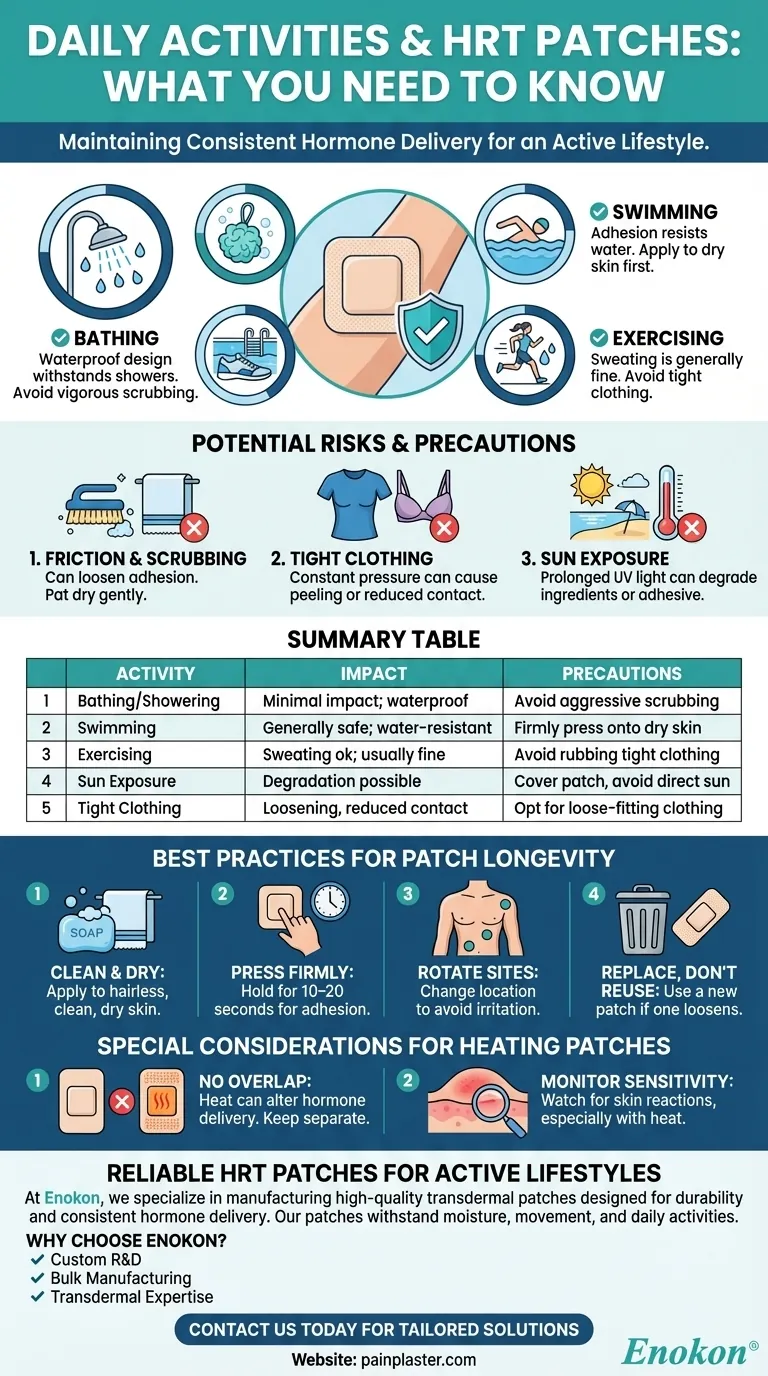Daily activities such as bathing, swimming, or exercising generally do not significantly affect hormone replacement therapy (HRT) patches when used correctly. The patches are designed to adhere well to the skin and withstand normal moisture exposure. However, excessive scrubbing, tight clothing, or prolonged direct sunlight (like sunbathing) should be avoided to prevent patch detachment or altered drug delivery. For those using heating patches for cramps, similar precautions apply to maintain adhesion and effectiveness.

Key Points Explained:
-
Compatibility with Daily Activities
- HRT patches are engineered to resist water exposure, making them suitable for bathing, showering, and swimming. The adhesive is typically waterproof, ensuring the patch stays in place during these activities.
- Exercise, including sweating, does not usually compromise the patch if it’s properly applied to clean, dry skin.
-
Potential Risks to Patch Integrity
- Scrubbing or Friction: Vigorous scrubbing (e.g., with a loofah or towel) near the patch site can loosen adhesion.
- Tight Clothing: Constant pressure from tight garments may cause edges to peel or reduce contact with the skin, affecting hormone absorption.
- Sun Exposure: Prolonged direct sunlight (e.g., sunbathing) might degrade the patch’s active ingredients or adhesive properties.
-
Best Practices for Patch Longevity
- Apply the patch to a hairless, clean area (e.g., abdomen or buttocks) and press firmly for 10–20 seconds to ensure adhesion.
- Rotate application sites to avoid skin irritation.
- If a patch loosens prematurely, replace it with a new one (avoid reusing the same patch).
-
Special Considerations for Heating Patches
- While HRT patches and heating patches for cramps differ in purpose, both rely on skin adhesion. Avoid overlapping them, as heat may alter hormone delivery.
- Monitor for skin sensitivity, especially if combining multiple patches or heat sources.
By following these guidelines, users can maintain consistent hormone delivery while accommodating an active lifestyle. Always consult a healthcare provider for personalized advice if issues persist.
Summary Table:
| Activity | Impact on HRT Patches | Precautions |
|---|---|---|
| Bathing/Showering | Minimal impact; patches are waterproof. | Avoid scrubbing the patch area aggressively. |
| Swimming | Generally safe; adhesive is designed to resist water. | Ensure the patch is firmly pressed onto dry skin before swimming. |
| Exercising | Sweating does not usually affect adhesion if applied correctly. | Avoid tight clothing that may rub against the patch. |
| Sun Exposure | Prolonged sunlight may degrade adhesive or active ingredients. | Cover the patch or avoid direct sunbathing. |
| Tight Clothing | Constant pressure may loosen edges or reduce skin contact. | Opt for loose-fitting clothing over the patch site. |
Need reliable HRT patches that stay put during daily activities?
At Enokon, we specialize in manufacturing high-quality transdermal patches designed for durability and consistent hormone delivery. Whether you're a healthcare distributor or a pharmaceutical brand, our patches are engineered to withstand moisture, movement, and active lifestyles while maintaining optimal adhesion.
Why choose Enokon?
✔ Custom R&D for tailored patch solutions
✔ Bulk manufacturing for seamless supply
✔ Expertise in transdermal technology for enhanced patient compliance
Contact us today to discuss your HRT patch needs and let our team deliver a solution that fits your requirements!
Visual Guide

Related Products
- Far Infrared Heat Pain Relief Patches Transdermal Patches
- Far Infrared Pain Patch Relief Pain Reliever for Back
- Heating Pain Relief Patches for Menstrual Cramps
- Far Infrared Knee Pain Patch Heat Patches for Pain Relief
- Far Infrared Deep Heat Relief Patches Medicated Pain Relief Patches
People Also Ask
- How do Deep Heat Pain Relief Patches provide pain relief? Discover the Drug-Free Mechanism
- What are the common side effects of using the medicated heat patch? Understanding Risks & Safe Use
- Are heat patches safe for all body parts? Key Safety Zones and No-Go Areas Explained
- How does the Deep Heat Back Patch work? A Drug-Free Solution for Targeted Pain Relief
- Can heat patches be used for fresh injuries? Avoid This Common Mistake for Faster Recovery
















